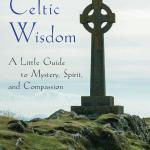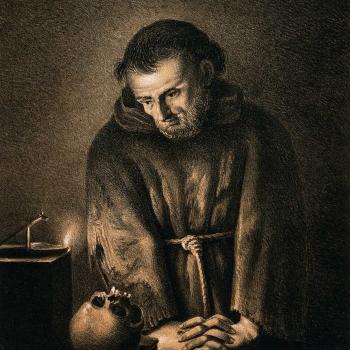
We know the first woman who wrote a book in the English language (at least, the first one that has been preserved for posterity).
But there is a lot about that author, who lived in the fourteenth century, that we don’t know.
We know she was a visionary based in Norwich, England. But we don’t know her name, where she was from or what her family life was like. We can only guess at her education or when she died. Even the date of her extraordinary mystical experience is up for grabs, thanks to the ambiguity that can be embedded in a handwritten manuscript.
Today (May 8) might be the anniversary of this mysterious woman’s extraordinary visions. But it might just as easily have been May 13.
In script, a “V” and an “X” are not so very different—so when one manuscript mentions May VIII, and another May XIII, we can assume that less than precise penmanship on the part of some long-forgotten scribe means that today we are left with a mystery that cannot be solved. We simply don’t know if Julian of Norwich (that’s not her name, but that’s what we call her) received her visions on the 8th or the 13th day of May, in the year 1373.
No worries, though. Anglican calendars typically remember Julian on the 8th, while Roman calendars prefer the 13th. I just make a point to remember the mystic of Norwich on both days and leave it at that. After all, the date of her life-changing encounter with Christ, and Mary, and even the fiend matters little when compared to the spiritual and theological insights contained in her visions.
Wisdom from a Medieval Solitary
We call the woman “Julian of Norwich,” because at some point—probably after her visionary experience—she became a consecrated solitary, living alone in a cell adjacent to the Church of St. Julian in Norwich. That church is dedicated to an obscure saint, the first bishop of Le Mans, France, who probably lived in the fourth century or even earlier. But the name of that church will forever be associated with the anonymous woman who dwelled within its walls a millennium after its patronal saint lived; indeed, today the church is a shrine for the mystic, a haven of rest and silence in a bustling modern English city.
Why all this fuss over someone almost totally consigned to medieval obscurity? Because of her words, of course.

Shortly after her visions, she recounted them in a relatively short manuscript, but she reworked it and expanded it, once and perhaps more than once, resulting in a “long text” alongside her earlier “short text.” Both versions of her story include detailed information on her visions, but the long text gives more interpretive, theological detail, presumably the fruit of years of meditation and reflection on the meaning of her visionary encounter.
Her best known line, “All shall be well, and all shall be well, and all manner of things shall be well” has become part of our larger cultural lexicon, thanks to T. S. Eliot, who nicked the line for one of his Four Quartets; the poem “Little Gidding.” This line is spoken by Christ himself in Julian’s vision, reassuring her that even though such a thing as sin exists, “all shall be well”—in God, even the worst elements of life will ultimately be healed.
But lest we accuse Julian of universalism, she repeatedly affirms all “the teaching of holy church” and leaves it to a “secret” in God as to just how all things shall be made well.
Julian is also renowned for her clever wordplay in which she deconstructs the masculine gender of God. “As truly as God is our father, so truly is God our mother,” she bluntly states, making her (like some other medieval mystical women) sort of an honorary foremother of feminist theology in our day. But Julian doesn’t just settle for a God in drag: her depictions of God are not only both maternal and paternal, but also sensual, anchored in natural imagery, and deeply trinitarian.
“Truth sees God, and wisdom beholds God. And of these two come the third, and that is a marvelous, holy delight in God, which is love.” Truth leads to a Pauline, intellectual apprehension of God, while wisdom ushers in a Johannine contemplation (“beholding”) of God—and the fruit of both of these is delightful love.
Then there is the hazelnut vision, where Julian sees “a little thing” small enough to rest in the palm of her hand—and which she is told “is all that is made.” Julian wonders that it continues to exist, which makes sense to me: imagine holding a tiny model of the entire cosmos small enough to rest in your hand; it would probably shine and shimmer and seem to have barely any substance at all. But in her understanding she receives this reassuring message: “It lasts and ever shall, for God loves it. And so all things have being through the love of God.”
Reflecting on this in her customary trinitarian way, Julian notes three qualities in this “little thing”: God made it, God loves it, and God keeps it. She goes on to reflect how human life is filled with angst because we seek our “rest”—our sense of identity, purpose, and pleasure—in the littleness of created things, rather than the vastness of Divine love.
Julian is no systematic theologian, nor is her writing intellectually demanding like the work of Thomas Aquinas or, for that matter, Meister Eckhart. She is more poet than philosopher. But her emphasis on love as the heart not only of God’s being but also God’s action in the universe leads to a theological vision that remains profoundly relevant here in the postmodern world. For Julian, Christ’s death is not a way to buy off the devil or to satisfy that righteous anger of God the Father. Rather, it is simply a vivid and sensual way to express Divine love: “No one has greater love than this, to lay down one’s life for one’s friends” (John 15:13).
And if Julian pulls a few punches when it comes to questions of how eternity will reconcile love and justice, this is understandable, for she lived in a time when heretics paid for their dissent with their lives. Even so, she has left us with a treasure that can aid in the monumental task to re-visioning the Gospel: the splendid proclamation of God’s love, a love that can break out from the confining limitations of the closed, reward-punishment system that has characterized juridical Christian theology for too long.
Which means after over six centuries, we still have barely begun to plumb the implications of her singular visions.
Want to explore Julian for yourself? Her original middle English voice is worth exploring, but if you’re new to her words, there are some useful modern-English translations; try The Showings of Julian of Norwich translated by Mirabai Starr. For a good brief introduction to Julian’s life and thought, check out Veronica Mary Rolf’s An Explorer’s Guide to Julian of Norwich.
Enjoy reading this blog?
Click here to become a patron.














